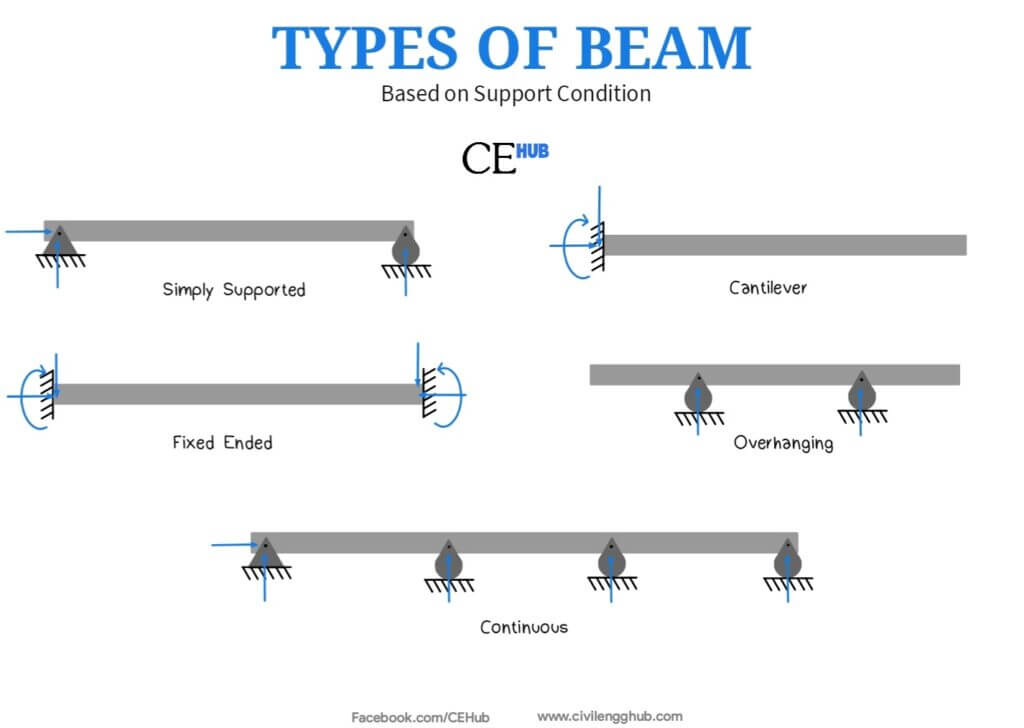What you’ll learn
- Beams in Structural Design
- Different Types of Beams (based on support conditions)
Beams
Beams are essential elements in structural systems, transferring vertical loads horizontally to supports like columns, walls, or foundations. While factors such as material and cross-sectional geometry influence how a beam performs, one of the most critical aspects is how it’s supported. Therefore, we’re going to discuss the different types of beams in structural design, and it’s importance on how their support conditions affect the overall performance of a structural design.
Support conditions directly impact how forces flow through a beam, how much it deflects, and where bending moments develop. Understanding these distinctions is key to designing safe, efficient structures.

1. Simply Supported Beam
This is the most basic beam setup. It rests on two supports—typically pinned at one end and on a roller at the other. These supports prevent vertical movement but allow the beam to rotate freely.
When discussing the different types of beams in structural design, it’s important to consider how their support conditions affect overall performance.
- Support Behavior: Fixed against vertical motion; free to rotate at both ends.
- Bending Moments: Zero at the supports; peak at mid-span under uniform loading.
- Shear Forces: Highest at supports, tapering toward the center.
- Deflection: Maximum occurs at mid-span with a parabolic shape.
- Design Simplicity: Statically determinate, meaning all reactions and internal forces are solvable using basic equilibrium equations.
Engineers often use simply supported beams in teaching and conceptual design due to their straightforward behavior.
2. Cantilever Beam
A cantilever is fixed at one end and free at the other. This setup concentrates forces and moments at the fixed support, demanding a strong connection to the structural frame or foundation.
- Support Behavior: No movement at the fixed end; the free end can rotate and displace vertically.
- Bending Moments: Greatest at the fixed end, tapering to zero at the free end.
- Shear Forces: Also highest at the fixed end.
- Deflection: Larger and more complex, especially under uniform loads.
Cantilevers are common in balconies, overhangs, and structures requiring open ends without vertical supports.
3. Fixed Beam
Fixed beams are rigidly connected at both ends, preventing both rotation and vertical movement. This restraint dramatically changes the beam’s behavior compared to simpler setups.
- Support Behavior: Fully restrained—no rotation or vertical displacement at either end.
- Bending Moments: Negative moments occur at supports, reducing mid-span moments.
- Shear Forces: More complex due to moment resistance at both ends.
- Deflection: Lower overall compared to simply supported beams.
Though they reduce deflection and material use, fixed beams introduce complications in construction and analysis due to their rigidity and indeterminate nature.
4. Continuous Beam
A continuous beam spans across three or more supports. This setup allows loads to be shared across multiple spans, increasing efficiency but adding analytical complexity.
- Support Behavior: Typically pinned or roller supports with intermediate supports that prevent vertical motion.
- Bending Moments: Alternate between negative (over supports) and positive (in mid-spans).
- Shear Forces: Variable, with noticeable changes at each support.
- Deflection: Generally lower than single-span beams due to load sharing.
- Design Complexity: Statically indeterminate to a degree based on the number of spans; requires tools like moment distribution, slope-deflection, or matrix methods.
Continuous beams are common in bridges and long-span buildings where structural efficiency is a priority.
5. Overhanging Beam
An overhanging beam extends past one or both supports. It’s essentially a simply supported beam with a cantilevered section added to one or both ends.
- Support Behavior: Mix of simply supported and cantilever characteristics.
- Bending Moments: Negative moments develop in the overhang and near adjacent supports.
- Shear Forces: Discontinuities appear where the overhang begins.
- Deflection: Complex; the overhang can significantly increase deflection if not accounted for properly.
Though less common in large-scale structures, overhanging beams are handy in architectural and small-scale applications.
Why Support Conditions Matter
Support conditions affect more than just static loads. They influence how a beam responds over time under sustained loading, how it behaves during seismic events, and how well it redistributes forces in real-world conditions. Misjudging or oversimplifying these conditions can lead to major errors in design and construction.






